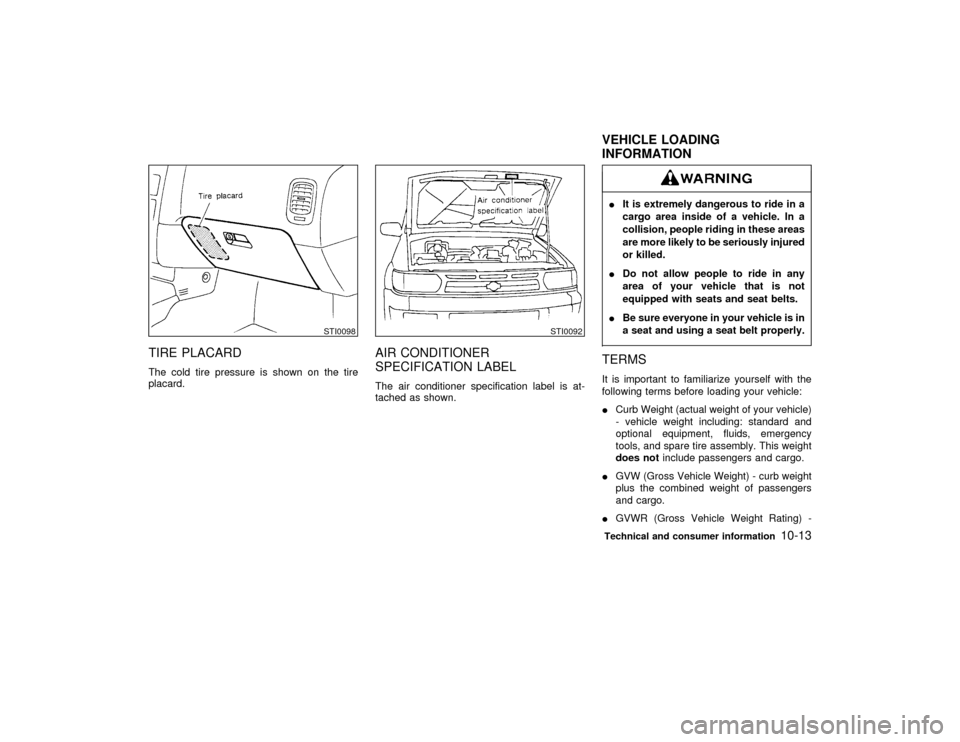1999 NISSAN PATHFINDER Tire pressure
[x] Cancel search: Tire pressurePage 233 of 274

Your new NISSAN has been designed to have
minimum maintenance requirements with
longer service intervals to save you both time
and money. However, some day-to-day and
regular maintenance is essential to maintain
your NISSAN's good mechanical condition, as
well as its emission and engine performance.
It is the owner's responsibility to make sure
that the specified maintenance, as well as
general maintenance, is performed.
As the vehicle owner, you are the only one
who can ensure that your vehicle receives the
proper maintenance care. You are a vital link
in the maintenance chain.
General maintenance:
General maintenance includes those items
which should be checked during normal day-
to-day operation of the vehicle. They are es-
sential if your vehicle is to continue to operate
properly. It is your responsibility to perform
these procedures regularly as prescribed.
These checks or inspections can be done by
yourself, a qualified technician or, if you prefer,
your NISSAN dealer.
Periodic maintenance:
The maintenance items listed in this part are
required to be serviced at regular intervals.However, under severe driving conditions, ad-
ditional or more frequent maintenance will be
required.
Where to go for service:
If maintenance service is required or your
vehicle appears to malfunction, have the sys-
tems checked and tuned by an authorized
NISSAN dealer.
NISSAN technicians are well-trained special-
ists and are kept up to date with the latest
service information through technical bulletins,
service tips, and in-dealership training pro-
grams. They are completely qualified to work
on NISSAN's vehicles before they work on
your vehicle, rather than after they have
worked on it.
You can be confident that your NISSAN deal-
er's service department performs the best job
to meet the maintenance requirements on your
vehicle Ð in a reliable and economic way.During the normal day-to-day operation of the
vehicle, general maintenance should be per-
formed regularly as prescribed in this section.
If you detect any unusual sounds, vibrations or
smell, be sure to check for the cause or have
your NISSAN dealer do it promptly. In addition,
you should notify your NISSAN dealer if you
think that repairs are required.
When performing any checks or maintenance
work, see ªMaintenance precautionsº in the ª8.
Do-it-yourselfº section.
EXTERIOR MAINTENANCEAdditional information on the following
items with * is found in the ª8. Do-it-
yourselfº section.Outside the vehicleThe maintenance items listed here should be
performed from time to time, unless otherwise
specified.
Tires*:
Check the pressure with a gauge periodically
when at a service station, including the spare,
and adjust to the specified pressure if neces-
sary. Check carefully for damage, cuts or
excessive wear.
MAINTENANCE PRECAUTIONS GENERAL MAINTENANCE9-2
Maintenance
Z
01.1.22/R50-D/V5
X
Page 256 of 274

TIRE PLACARDThe cold tire pressure is shown on the tire
placard.
AIR CONDITIONER
SPECIFICATION LABELThe air conditioner specification label is at-
tached as shown.
IIt is extremely dangerous to ride in a
cargo area inside of a vehicle. In a
collision, people riding in these areas
are more likely to be seriously injured
or killed.
IDo not allow people to ride in any
area of your vehicle that is not
equipped with seats and seat belts.
IBe sure everyone in your vehicle is in
a seat and using a seat belt properly.TERMSIt is important to familiarize yourself with the
following terms before loading your vehicle:
ICurb Weight (actual weight of your vehicle)
- vehicle weight including: standard and
optional equipment, fluids, emergency
tools, and spare tire assembly. This weight
does notinclude passengers and cargo.
IGVW (Gross Vehicle Weight) - curb weight
plus the combined weight of passengers
and cargo.
IGVWR (Gross Vehicle Weight Rating) -
STI0098
STI0092
VEHICLE LOADING
INFORMATIONTechnical and consumer information
10-13
Z
01.1.22/R50-D/V5
X
Page 260 of 274

TOWING SAFETY
Trailer hitchCheck the towing capacity of your receiver
type frame mounted hitch. Choose a proper
hitch for your vehicle and trailer. A genuine
NISSAN trailer hitch is available from your
NISSAN dealer (Canada only). Make sure the
trailer hitch is securely attached to the vehicle,
to help avoid personal injury or property dam-
age due to sway caused by crosswinds, rough
road surfaces or passing trucks.ISpecial hitches which include frame
reinforcements are required for tow-
ing above 2,000 lb (907 kg). Suitable
Genuine NISSAN hitches for pickup
truck and Pathfinder models are
available at your Nissan dealer.
IDo not use axle-mounted hitches.
IDo not modify the vehicle exhaust
system, brake system, etc. when the
hitch is installed. After the hitch is
removed, seal the bolt holes to pre-
vent exhaust fumes, water or dustfrom entering the passenger com-
partment.
ICheck regularly to make sure that all
trailer hitch mounting bolts are se-
curely fastened.
ITo reduce the possibility of additional
damage if your vehicle is struck from
the rear, where practical, remove the
hitch when not in use. Remove the
receiver when not in use.
Tire pressuresIWhen towing a trailer, inflate the vehicle
tires to the recommended cold tire pressure
indicated on the tire placard (affixed to the
glove box lid).
ITrailer tire condition, size, load rating and
proper inflation pressure should be in ac-
cordance with the trailer and tire manufac-
turers' specifications.Safety chainsAlways use a suitable chain between your
vehicle and the trailer. The chain should be
crossed and should be attached to the hitch,
not to the vehicle bumper or axle. Be sure toleave enough slack in the chain to permit
turning corners.
Trailer lightsTrailer lights should comply with Federal
and/or local regulations.
When wiring vehicle for towing connection,
connect stop and tail light pickup into the
vehicle electrical circuit at point between
the sensor and stop light switch or light
switch.Trailer brakesIf your trailer is equipped with a braking sys-
tem, make sure it conforms to Federal and/or
local regulations and that it is properly in-
stalled.Never connect a trailer brake system
directly to the vehicle brake system.Trailer towing tipsIn order to gain skill and an understanding of
the vehicle's behavior, you should practice
turning, stopping and backing up in an area
which is free from traffic. Steering stability andTechnical and consumer information
10-17
Z
01.1.22/R50-D/V5
X
Page 270 of 274

Remote keyless entry, (See multi-remote control
system) ............................................................. 3-5
Reporting safety defects (USA only) ............ 10-19
Rollover ............................................................. 5-4
SSafety
Child seat belts.......................................... 1-24
Infiniti Communicator operating ................ 2-42
Reporting safety defects (USA only)....... 10-19
Towing safety .......................................... 10-17
Seat adjustment
Front manual seat adjustment .................... 1-2
Rear seat adjustment .................................. 1-6
Seat belt extenders......................................... 1-30
Seat belt hook................................................. 1-28
Seat belt maintenance .................................... 1-30
Seat belt warning light .................................... 1-22
Seat belt warning light and chime .................. 2-10
Seat belt(s)
Child safety................................................ 1-24
Infants and small children ......................... 1-24
Injured persons.......................................... 1-25
Larger children .......................................... 1-24
Precautions on seat belt usage ................ 1-23
Pregnant women ....................................... 1-24
Seat belt cleaning........................................ 7-4
Seat belts .................................................. 1-22
Three-point type with retractor .................. 1-25
Two-point type without retractor (rear center
lap belt)...................................................... 1-28
Seat(s)
Heated seats ............................................. 2-23Seats ........................................................... 1-2
Security system (See theft warning)............... 2-14
Servicing air conditioner................... 4-3, 4-9, 4-11
Shifting, Manual transmission ......................... 5-13
Shoulder belt height adjustment, For front
seats ............................................................... 1-27
Side air bag system (See supplemental side air
bag system) .................................................... 1-10
Spark plugs ..................................................... 8-15
Speedometer .................................................... 2-3
Spot lights ....................................................... 2-35
Starting
Before starting the engine ........................... 5-8
Jump starting ............................................... 6-8
Precautions when starting and driving ........ 5-2
Push starting ............................................. 6-10
Starting the engine ...................................... 5-8
Steering
Power steering fluid................................... 8-11
Power steering system .............................. 5-24
Tilting steering wheel ................................ 3-14
Storage ........................................................... 2-25
Sun shade....................................................... 2-35
Sun visors ....................................................... 3-14
Sunroof, Automatic sunroof ............................ 2-34
Supplemental air bag system ......................... 1-16
Supplemental air bag warning labels ............. 1-20
Supplemental air bag warning light ....... 1-20, 2-10
Supplemental restraint system ....................... 1-10
Precautions on supplemental restraint
system ....................................................... 1-10
Supplemental side air bag system ................. 1-10
Switch
Fog light switch ......................................... 2-22Glass hatch and outside mirror defogger
switch......................................................... 2-18
Hazard warning flasher switch .................. 2-22
Headlight switch ........................................ 2-18
Ignition switch .............................................. 5-6
Ignition switch automatic transmission
models ......................................................... 5-7
Ignition switch manual transmission
models ......................................................... 5-6
Overdrive switch ........................................ 5-12
Turn signal switch ..................................... 2-21
T
Tachometer ....................................................... 2-4
Temperature display ......................................... 2-6
Temperature gauge, Engine coolant temperature
gauge ................................................................ 2-4
Three way catalyst ............................................ 5-3
Tilting steering wheel ...................................... 3-14
Tire
Flat tire ........................................................ 6-2
Tire chains ................................................. 8-28
Tire placard ............................................. 10-13
Tire pressure ............................................. 8-26
Tire rotation ............................................... 8-28
Type of tires .............................................. 8-27
wheel/tire size.......................................... 10-10
Wheels and tires ....................................... 8-26
Top tether strap child restraints ...................... 1-40
Towing
Tow truck towing ....................................... 6-11
Towing a trailer........................................ 10-15
Towing load/specification chart ............... 10-15
Z
01.1.22/R50-D/V5
X
11-5
Page 272 of 274

FUEL RECOMMENDATION:Your vehicle is designed to operate on un-
leaded gasoline with an octane rating of at
least 87 AKI (Anti-Knock Index) number (Re-
search octane number 91).Using a fuel other than that specified
could adversely affect the emission con-
trol devices and systems, and could
also affect the warranty coverage.
Under no circumstances should a
leaded gasoline be used since this will
damage the three way catalyst.For additional information, see ªCapacities and
recommended fuel/lubricantsº in the ª10.
Technical and consumer informationº section.ENGINE OIL RECOMMENDATION:IAPI Certification Mark
IAPI grade SG/SH, Energy Conserving II or
API grade SJ, Energy Conserving.
IILSAC grade GF-II.
ISAE 5W-30 viscosity oil is preferred for all
ambient temperatures.See ªCapacities and recommended
fuel/lubricantsº in the ª10. Technical and con-
sumer informationº section for engine oil and
oil filter recommendation.
COLD TIRE PRESSURES:See the tire placard affixed to the glove box.NEW VEHICLE BREAK-IN
PROCEDURES
RECOMMENDATION:During the first 1,000 miles (1,600 km) of
vehicle use, follow the recommendations out-
lined in the ªBreak-in scheduleº Information
found in the ª5. Starting and drivingº section of
this Owner's Manual. Follow these recommen-
dations for the future reliability and economy of
your new vehicle. Failure to follow these rec-
ommendations may result in vehicle damage
or shortened engine life.
GAS STATION INFORMATION
Z
01.1.22/R50-D/V5
X